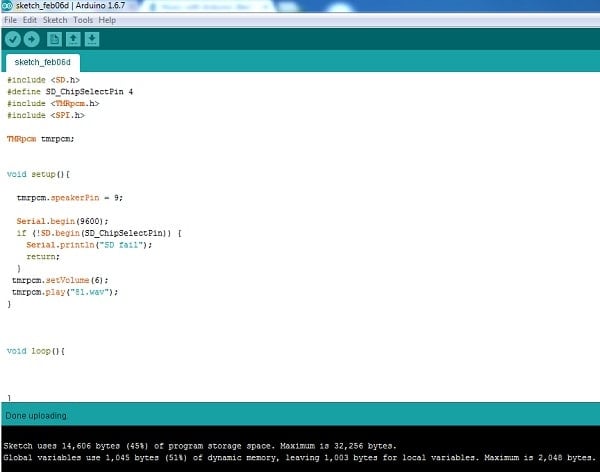
- #Arduino speaker code how to
- #Arduino speaker code generator
- #Arduino speaker code serial
- #Arduino speaker code code
- #Arduino speaker code free
After a quick search on digikey, these looked good, for Arduino, try to find something that will run off a single 5V supply.
#Arduino speaker code code
Downsides are they are a little more challenging to program, more expensive, and will not work with the code in this Instructable, though I'm sure there are some other tutorials available. These chips are generally higher fidelity (definitely better quality that the resistor ladder DAC) and they only use two or three of the Arduino's output pins (as opposed to 8).
#Arduino speaker code serial
You can buy a chip that works in the exact same was as an R2R DAC (and will work with all the code in this instructable), but has internal, highly-matched resistors for better audio quality, I like this one bc it runs off a single 5V supply (you can even do stereo audio with it), but there are many more available, look for "parallel input, 8 bit, dac ic".Īlternatively, there are chips that take in serial data to perform digital to analog conversion. I like using these resistor ladder DACs because I always have the materials around, they're cheap, and I think they're kind of fun, but they will not give you the highest quality audio. I connected each of digital pins 0-7 to each of the 8 junctions in my 8 bit DAC (shown in figs 1 and 3). The resistor ladder I'll be demonstrating in this tutorial is an 8-bit DAC, this means it can produce 256 (2^8) different voltage levels between 0 and 5v. You can think of a resistor ladder as a multi-leveled voltage divider. Essentially, it takes incoming digital bits (0V and 5V from Arduino), weights them, and sums them to produce a voltage between 0 and 5 volts (see the schematic in fig 2, taken from the Wikipedia resistor ladder page). A simple, easy to program, and cheap way to do this is to use something called an R2R resistor ladder. (1x) usb cable Amazon (1x) breadboard (this one comes with jumper wires) Amazon (1x) jumper wires AmazonĭAC stands for "digital to analog converter." Since the Arduino does not have analog out capabilities, we need to use a DAC to convert digital data (numbers/ints/bytes) to an analog waveform (oscillating voltage). (x9) 1/4 Watt 20kOhm Resistors Digikey 0KQBK-ND (x7) 1/4 Watt 10kOhm Resistors Digiikey CF14JT10K0CT-ND (x2) TS922IN Digikey 497-3049-5-ND I like these because they can be powered off the Arduino's 5V supply (one 924 works too, but they don't seem to be available on digikey at the moment) (x1) 10kOhm potentiometer linear Digikey 987-1308-ND (x1) 0.01uF capacitor Digikey 445-5252-ND (x1) 220uF capacitor Digikey P5183-ND (x1) 0.1uF capacitor Digikey 445-5303-ND (x1) 1/4 Watt 3kOhm Resistor Digikey CF14JT3K00CT-ND (x1) 1/4 Watt 10Ohm Resistor Digikey CF14JT10R0CT-ND (x1) Arduino Uno Amazon
#Arduino speaker code free
The circuits and code provided here are compatible with SD shields that communicate via SPI.įeel free to use any of the info here to put together an amazing project for the DIY Audio Contest! We're giving away an HDTV, some DSLR cameras, and tons of other great stuff! The contest closes Nov 26.
#Arduino speaker code how to
With the addition of an SD shield you could create your own Arduino mp3 player (check out the wave shield documentation for an idea of how to get started with the code).

audio playback device- make your own ipod. Check out my vocal effects box for an example.
#Arduino speaker code generator
digital synthesizer- make saw, sine, triangle, pulse, or arbitrary waveshapes- check out my waveform generator to get started MIDI to control voltage module/ MIDI synthesizer- receive MIDI messages and translate them into a voltage so you can control an analog synthesizer with MIDI, or use the MIDI data to output audio of a certain frequency analog output- you may find yourself needing to generate analog voltages from your Arduino at some point, maybe to communicate with an analog device effects box/digital signal processing- in combination with a microphone/audio input you can perform all kinds of digital signal manipulations and send the processed audio out to speakers. Check out my Arduino drum sampler for an idea of how to get started. Sample based instrument- store samples on the Arduino or on an SD card and trigger playback with buttons or other types of controls. (This article is a companion to another Instructable I've written about sending audio into an Arduino, find that here) This Instructable will show you how to set up a really basic digital to analog converter so you can start generating analog waves of all shapes and sizes from a few digital pins on an Arduino.


defining the notes with freq.Generate sound or output analog voltages with an Arduino.


 0 kommentar(er)
0 kommentar(er)
